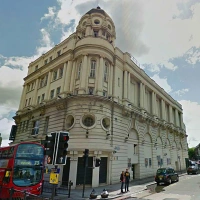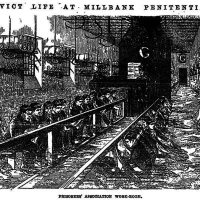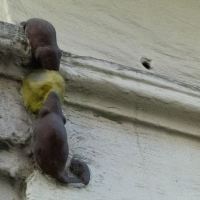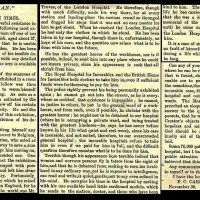Introducing the View From the Mirror Archive- a new contents page
To date, I’ve written and posted over 270 articles on this site.
Due to the nature of blogging software these posts get pushed further and further back as time progresses meaning it can be tricky to discover older content.

To overcome this problem I’ve developed a new contents page where links and brief descriptions of every single article can be found.
Please click here or on the link in the menu bar above to access…
Enjoy!
From London to Lockerbie: The 30th Anniversary of Pan Am 103
The late 1980s were notable for a relentless string of disasters which affected Britain; the Zeebrugge ferry capsize, the King’s Cross fire, the Piper Alpha oil platform explosion, the Hillsborough Disaster and, as seen recently on this site, the Clapham rail crash.
Christmas 2018 marks the thirtieth anniversary of another of these appalling catastrophes: The Lockerbie bombing.
* * *
The bar at Heathrow’s Terminal 3 heaved with Christmas travellers as Jaswant Basuta enjoyed a drink with his brother-in-law.

Heathrow in the late 1980s
As Sikhs, the consumption of alcohol was discouraged but that late afternoon of December 21st 1988 was an exception as Jaswant- who’d been visiting relatives in Southall, west London- was about to begin a job in New York and a merry send off was in order.

Jaswant Basuta in 2018 (image: UGC/The Daily Record)
The beer flowed too easily however and before long Jaswant realised he was running late. After hasty goodbyes he jogged through Terminal 3’s seemingly endless corridors and arrived breathless at Gate 14– only to find it’d just closed.
Despite his pleas, Jaswant was refused entry to the flight that he could now see backing away from the gate: Pan Am 103.
*
Jaswant wasn’t the only person to miss that fateful flight bound for New York’s JFK Airport.
Also booked on Pam Am 103 were Motown legends, The Four Tops.

The Four Tops in 1968 (image: Wikipedia)
On December 21st the group were at BBC Television Centre, Shepherds Bush recording a performance of their latest release, ‘Loco in Acapulco’ for a festive edition of Top of the Pops.
A second recording- this time of their classic 1967 hit, ‘Reach Out I’ll Be There’ which was to be broadcast on the show’s new year special- was also scheduled and the group were hoping to get it in the can as quickly as possible so they could get going to Heathrow.
The show’s producer however cared little for the Four Top’s travel plans and refused to rush the schedule.
Although the group were understandably frustrated at the time, the delay saved their lives.
*
In Harrods meanwhile, actress Kim Catrell, who was in the UK working on ‘The Return of the Musketeers’, was purchasing a Wedgwood teapot for her mother. She too had a seat on Pan Am 103 but switched flights at the last minute in order to complete her Christmas shopping.
A clip of Kim discussing her decision can be viewed below:
Elsewhere, former Sex Pistols frontman John Lydon (aka Johnny Rotten) who, despite his anarchic image, was a self-confessed stickler for time, was embroiled in a heated row with his wife, Nora whose slowness in packing meant they too had no chance of making the flight.

John Lydon in his punk heyday
The couple would soon realise just how lucky they were.
*
Back at Heathrow, Pam Am 103- a 747 Pan-American Jumbo Jet named ‘Clipper Maid of the Seas’- taxied on the crowded tarmac.
The jet was a real workhorse, having flown in to London from San Fransisco just a few hours before. Now cleaned and refuelled, it was ready to head back out across the Atlantic.

Pan Am’s ‘Clipper Maid of the Seas’ pictured at Frankfurt Airport in 1986 (image: Wikipedia)
The Boeing 747 was one of the earliest built, having been delivered to Pan American Airlines in 1970. The company had originally christened the aircraft ‘Clipper Morning Light’ but changed the name to ‘Clipper Maid of the Seas’ in 1979.

The 747 under its original name, ‘Clipper Morning Light’ at San Francisco Airport in 1978 (image: Wikipedia)
Shortly before its name was changed the aircraft appeared in the 1978 BBC documentary ‘Diamonds in the Sky’; a series which explored the history of aviation.
The specific episode- ‘Conquering the Atlantic’- featured footage from both inside and outside the 747 as it made a routine flight from London to New York; the same route it was set to travel ten years later on December 21st 1988.
This now extremely poignant episode can be viewed in its entirety below:
*
Onboard Clipper Maid of the Seas were 259 passengers and crew, including 35 students from New York State’s Syracuse University who’d just completed an international semester in London.
At 6.18pm the 747’s engines howled into life, powering the huge aircraft along the runway. As it lifted and began to climb through the dark winter sky over west London, air-traffic controller, Richard Dawson watched from Heathrow’s tower and, over the radio, wished the crew goodnight.
Unbeknownst to all, a brown Samsonite suitcase belonging to nobody onboard lurked within the jumbo’s hold.

A Samsonite case similar to the one loaded onboard Pan Am 103 (image: The Telegraph)
Inside the case, bundled amongst clothing, was a Toshiba ‘Bombeat’ radio-cassette player packed with a small, but lethal amount of Semtex.
At around 7pm, 38 minutes after departing Heathrow, Pan Am 103 reached its cruising altitude of 31,000 ft and radioed Scotland’s Prestwick air-traffic control to request clearance across the Atlantic Ocean.
The communication was handled by controller Alan Topp who, moments later, saw Flight 103 vanish from his radar screen.

Reconstruction of the moment Alan Topp saw Pan Am 103 disappear from his radar screen
At the same moment residents in Lockerbie– a small, friendly town in the Scottish borders just north of Gretna Green and approximately 70 miles south of Glasgow- heard a deep rumble of thunder overhead which rapidly crescendoed into a deafening roar.
Several miles above, the Semtex bomb onboard Pan Am 103 had detonated, causing a catastrophic structural failure which ripped the 747 apart.
With its engines still running and wings fully loaded with aviation fuel, the aircraft’s devastated sections plummeted towards Lockerbie in flames, smashing into the ground with terrifying force.
An animation depicting the moment the device detonated can be viewed below:
At around the same time, a British Airways flight from Glasgow to London passed high overhead.
Glancing down from the cockpit window, pilot Robin Chamberlain saw an inferno thousands of feet below, later describing the sight as “Something that looked like the burning oil fields you see in the Middle East.”
A BBC newsflash reporting the disaster can be viewed below:
*
Wreckage and bodies from the doomed flight were spread over a wide area; across fields, in trees, on rooftops and in back gardens.
Homes were reduced to rubble and 11 residents on Lockerbie’s Sherwood Crescent were vaporised in an almighty fireball.
According to one of the first reporters on the scene, the immediate aftermath of flaming rubble set against the night sky resembled “the London Blitz of 1940”, whilst a Lockerbie resident likened it to “Walking into hell”.
Another Lockerbie resident, Ella Ramsden– who narrowly escaped with her life when her home was destroyed- was convinced armageddon had been unleashed.

A blazing impact crater at Lockerbie
All onboard Pan Am 103 perished.
Combined with victims on the ground, a total of 270 people were killed.
*
It wasn’t until 2000 that the individual accused of the terrorist act- Libyan national, Abdelbaset al-Megrahi– was tried at a purpose built court in the Netherlands, the witness box of which is now displayed in the Imperial War Museum.

Abdelbaset al-Megrahi
Found guilty of the deaths of all 270 victims, al-Megrahi was sentenced to life but was controversially released on compassionate grounds in 2009 after being diagnosed with terminal cancer.
Al-Megrahi however always protested his innocence and there are many- including some relatives of those killed- who believe he was framed and that many questions remain unanswered.
The circumstantial evidence for example used to convict Megrahi was dubious, based upon the testimony of Maltese shopkeeper, Tony Gauci who claimed to have recalled the Libyan purchasing clothing (fragments of which were found in the wreckage at Lockerbie) in his shop.
It was later revealed that Gauci had been secretly paid a huge sum for providing this evidence.

The late Tony Gauci whose statement was key in securing a guilty verdict
It was also said that al-Megrahi had planted the bomb by checking it in at Malta’s Luqa Airport from where it travelled to London via Frankfurt.
At the trial however no mention was made about a mysterious security breach which had occurred within Heathrow’s baggage during the early hours of December 21st 1988 when a door lock was found to have been snapped with bolt cutters.
Also, according to Heathrow baggage handler, John Bedford, an out of place brown Samsonite case was spotted on a Pan-Am 103 luggage container before the connecting flight from Frankfurt had even landed.
Sadly, 30 years on, it seems we will never have full closure over what precisely lay behind the Lockerbie atrocity.

***
The 30th Anniversary of the Clapham Rail Disaster
(Please note this article contains details and images which some readers may find upsetting)
30 years ago, just before 7.20am on the chilly morning of Monday December 12th 1988, the characteristic sound of doors slamming shut on an old-style British Rail train echoed along the platform at Basingstoke station as hundreds of commuters crammed into a service bound for London Waterloo.

Two ‘slam-door’ trains in 1986 (image: Wikipedia)
For the next forty minutes the train rattled along without incident.

View from a slam-door train compartment
That was until it approached a green signal which suddenly flickered to red without warning.
Unable to stop in time, the driver- Alexander McClymont– halted the train in a cutting on Wandsworth Common, just before Battersea Rise and about half a mile south of Clapham Junction station, where he climbed down from the cab and used a trackside telephone to inform the nearest signal box of the problem.
After being told there was nothing to worry about Alexander hung up but as he did so a second train- this one heading up from Bournemouth- roared around the corner at approximately 50mph.
The time was 8.13am.

The railway cutting through Wandsworth Common
According to witnesses onboard, the driver of this train- John Rolls– barged through the door of his cab in the final seconds before impact, no doubt realising it was impossible to brake in time.
The Bournemouth train ploughed into the Basingstoke service, killing John and many others instantly. To those nearby, it sounded like a bomb had gone off.
Lee Middleton– a survivor on the Bournemouth train- described the moment: “I heard a deafening noise and then all hell let loose. We were getting thrown around the carriage like rag dolls… I heard crying and moaning… I thought it was curtains for me.”
Lee found himself pinned beneath the wreckage, his gaze forced towards the clear winter sky which had been exposed after the carriage roof was, as another survivor put it, “split open like a ripe tomato.”

Rescuers amongst the twisted carriages
Back at the trackside meanwhile, Alexander could only watch in horror as carriages from his Basingstoke train were thrown into the air, hurling a number of passengers out. He immediately snatched the phone back to alert the signal box and call for emergency services.
To make matters even worse a third train tore into the area moments later, smashing into the already tangled wreckage. Mercifully this train was empty, although tragically a number of people who’d been ejected from the Basingstoke carriages were crushed beneath its wheels.
It was only by sheer fortune that a fourth train managed to stop in time just yards from the carnage.

Diagram of the crash site printed in The Times newspaper shortly after the disaster (image: The Times)
Alongside personnel from London’s emergency services- including doctors who performed a number of operations and amputations on site, the greatest heroes that day were pupils from the Emanuel School which is located on the embankment overlooking the disaster zone.

The Emanuel School today (image: Google)
Upon hearing the terrifying smash, teenagers far too young to witness the horror they were about to encounter scrambled down the slope to help. The very first person to enter the stricken carriages was Terry Stoppani whose birthday it happened to be that day.
He’d just turned 12 years old.

Terry Stoppani being interviewed about the role he played in rescuing victims (image: The Times)
“There was a huge bang, just like a bomb explosion” Terry explained when interviewed. “I saw all parts of the train flying into the air…we jumped over the railings and climbed into the train through a broken window. The first thing I saw was legs with jeans and shoes on. There was no top half of the body… In the train people were screaming and too frightened to talk. We started pulling people out through the window.”

Rescue workers at the disaster site
Another pupil- 18 year old sixth former, Simon Murie– yanked wreckage away with his bare hands, comforting victims as he did so.
Another un-named 14 year old held a trapped passenger upright in their twisted seat for several hours before they could be freed.
Many of the passengers were in a deep state of shock, so much so that they were unable to comprehend where they were or what had happened.

Ariel view of the crash site alongside Spencer Park
The young rescuers from the Emanuel School were praised by Prime Minister Margaret Thatcher and visited by the Secretary of State for Education who thanked them personally for “Their immense courage and maturity.”
A BBC news report from the evening of December 12th 1988 detailing the catastrophe can be viewed below:
*
Overall 35 people were killed and hundreds more injured in what became known as the Clapham Rail Disaster.
Amongst the dead was technician Michael Newman whose glittering theatre signs for shows such as ‘Cats’, ‘Singing in the Rain’ and ‘Phantom of the Opera’ earned him the nickname, “the man who brought the West End to light.”
On a personal note, my father knew Mike and had worked alongside him installing these famous displays.

Several victims of the Clapham Rail Disaster were pictured in the news the following day. Michael Newman, who my father knew personally, can be seen in the bottom right hand corner (image: The Times)
*
It was determined that the cause of the accident- the light which had inexplicably flicked from green to red- was down to faulty signal wiring housed within a unit that was approximately fifty years old.
The electrician who’d overlooked the fault had been on voluntary overtime which had seen him working seven days a week for the past thirteen weeks; a regime which had inevitably led to exhaustion. It was also noted his training, assessment and supervision had been woefully inadequate.
As a result, British Rail were fined £250,000 although many believed the company should’ve been prosecuted for Corporate Manslaughter.
In 1989 a memorial to those who were killed and injured was unveiled on Spencer Park which overlooks the site of the tragedy.

The Clapham Rail Crash Memorial at Spencer Park (image: Geograph)
At 8.13am on Wednesday 12th December 2018, the train drivers’ union, ASLEF will be staging a two minute silence beside the memorial to mark the disaster’s thirtieth anniversary.
***


































